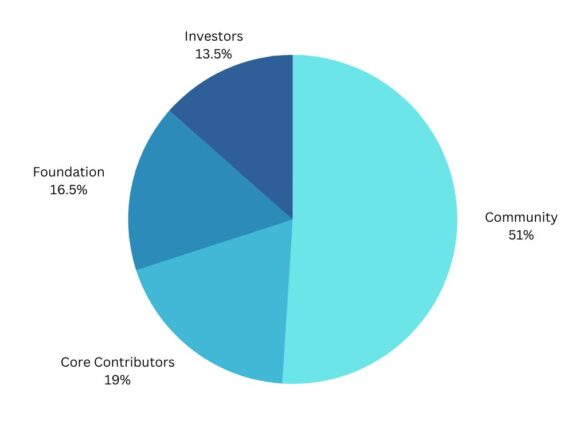What Is Aptos? Inside the New Move-Based Layer 1 Chain
Meta's failure to launch its blockchain-based stablecoin project Diem has led several of its employees to leave and develop their own Layer 1 blockchains. The first of these to launch—and do so with a bang—is Aptos.

Key Takeaways
- Aptos is a new high-throughput Layer 1 blockchain that uses a novel smart contract programming language called Move.
- The project is considered the technological successor of Meta’s abandoned blockchain network, Diem.
- Due to its stated theoretical throughput of 100,000 transactions per second, Aptos has been dubbed a potential "Solana killer."
Share this article
Aptos is a scalable Proof-of-Stake Layer 1 blockchain that uses a novel smart contract programming language called Move. The project is developed by Aptos Labs, a blockchain startup led by two former Meta employees.
Aptos Unpacked
Aptos is a Proof-of-Stake-based Layer 1 blockchain that combines parallel transaction processing with a new smart contract language called Move to achieve a theoretical transaction throughput of over 100,000 transactions per second. The project is the brainchild of two former Meta engineers, Mo Shaikh and Avery Ching, and is considered the technological successor of Meta’s abandoned blockchain project Diem.
Aptos first made waves in the crypto industry in March this year after it emerged that it had raised $200 million in a seed round led by the renowned venture capital firm Andreessen Horowitz. In July, the startup raised another $150 million at a $1.9 billion pre-money valuation in a Series A funding round led by FTX Ventures and Jump Crypto, before its valuation hit $4 billion two months later in a venture raise led by Binance Labs.
It is worth highlighting that Aptos did all this before launching its blockchain, which only went live on mainnet on October 17. To reward the early users of its testnet and fairly distribute the initial token allocation, Aptos airdropped 150 APT tokens (worth approximately $1,237 on launch) to 110,235 eligible addresses. Per CoinGecko data, Aptos currently has a fully diluted market capitalization of around $9.2 billion despite launching only a few days ago with little activity happening on the network. Beyond its provenance and links to Meta, the project’s valuation has raised questions.
What Makes Aptos Special?
From a technical perspective, the driving force behind Aptos can be boiled down to two things: Move, the Rust-based programming language independently developed by Meta, and the network’s unique parallel transaction processing abilities.
Move is a new smart contract programming language that emphasizes safety and flexibility. Its ecosystem contains a compiler, a virtual machine, and many other developer tools that effectively serve as the backbone of the Aptos network. Although Meta originally wanted Move to power the Diem blockchain, the language was designed to be platform-agnostic with ambitions to evolve into the “JavaScript of Web3” in terms of usage. In other words, Meta intended for Move to become the developers’ language of choice for writing safe code involving digital assets quickly.
Using Move, Aptos was built to theoretically achieve high transaction throughput and scalability without sacrificing security. It leverages a pipelined and modular approach for the critical stages of transaction processing. For context, most blockchains, especially the top ones like Bitcoin and Ethereum, execute transactions and smart contracts sequentially. In simple terms, this means that all transactions in the mempool—where all submitted transactions await confirmation by the network’s validators—must be verified individually and in a specific order. This means that the growth of the network’s computing power doesn’t translate into faster transaction processing because the entire network is effectively doing the same thing and acting as a single node.
Aptos differs from other blockchains in its parallelized approach to transaction processing and execution, which means that its network leverages all available physical resources to process many transactions simultaneously. This leads to much greater network throughput and transaction speeds, resulting in significantly lower costs and a better user experience for blockchain users. Expanding on this issue in its technical whitepaper, Aptos says:
“To maximize throughput, increase concurrency, and reduce engineering complexity, transaction processing on the Aptos blockchain is divided into separate stages. Each stage is completely independent and individually parallelizable, resembling modern, superscalar processor architectures. Not only does this provide significant performance benefits, but also enables the Aptos blockchain to offer new modes of validator-client interaction.”
However, while Aptos claims to have already achieved 10,000 transactions per second on testnet and aims for 100,000 transactions per second as the next milestone, users should take its claims with a grain of salt as they’re yet to be battle-tested. Other Layer 1 networks and sidechains making similar claims, including Solana and Polygon, have suffered numerous network outages since their inception and have otherwise been criticized for being too centralized.
Dubious Tokenomics
On October 17, Aptos triggered significant outrage within the crypto community when it launched its blockchain and native governance and utility token APT without first disclosing its total supply, distribution, or issuance rate to the public. After APT’s price plummeted by roughly 40% in the initial trading hours, Aptos tried to rectify its mistake and calm the community’s outrage by revealing its tokenomics.

Despite the generous airdrop to over 100,000 addresses, the move toward transparency was met with even more outrage after the community learned that the entire token supply was allocated to early investors and the company. Namely, instead of giving the community the 51% of tokens allegedly assigned to it directly, either through airdrops, grants, or staking rewards, Aptos allocated them to Aptos Labs and the Aptos Foundation. Moreover, according to the team’s blog post, “82% of the tokens on the network are staked across all categories,” meaning that the company and early insiders will earn the majority of staking rewards which are not subject to lockups.
Beyond that, Aptos currently has a circulating supply of 130 million tokens, a total supply of 1,000,935,772, and an uncapped maximum supply. According to the official token supply schedule, the inflation rate will start at 7% and decline by 1.5% annually until it reaches an annual supply rate of 3.25% (expected to take over 50 years). The transaction fees will initially be burned, though this mechanic may be revised through governance voting in the future.
Is Aptos the Next Solana Killer?
Despite running for less than a week, Aptos has already been heralded as a potential “Solana killer.” This is primarily due to its stated throughput of 100,000 transactions per second. For comparison, Solana can only handle about 60,000—but it suffers network-wide outages on a regular basis.
Beyond the high scalability, Aptos shares other similarities with Solana, including the strong venture capital backing and the top-down approach to ecosystem building. With a war chest counting several billion dollars from the get-go and the allure of being the “shiny new thing,” Aptos could very well steal Solana’s spotlight in the future if it can grow a thriving ecosystem. Besides, it should certainly help that Austin Virts, the former Head of Marketing at Solana, is now in charge of ecosystem building at Aptos.
All considered, Solana is still miles ahead of Aptos regarding ecosystem health and network adoption. By keeping its tokenomics opaque and allocating most of the supply to early investors and insiders, Aptos began its crypto journey on shaky terms with the crypto community, which could hurt it in the long run. However, if Aptos delivers even half of what it has set to achieve on the technological front, then it has a shot at capturing a significant market share from all other smart contract-enabled Layer 1 networks.
Disclosure: At the time of writing, the author of this feature owned ETH and several other cryptocurrencies.
Share this article
